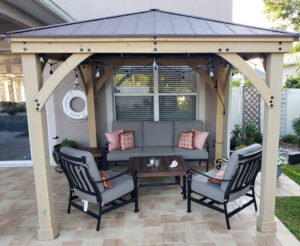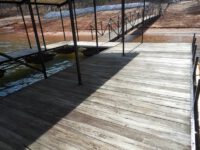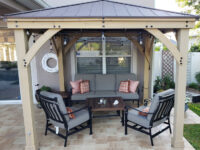How to Build a Concrete Gazebo
A concrete pavilion provides a sturdy and permanent structure for your backyard. However, the concrete foundation must be poured and leveled before you can assemble the gazebo. This is a major task that requires specialized tools and expertise.
It is also important to consider the environment – especially if you live in an area with high winds. Proper installation techniques and weather precautions are critical to a durable, long-term gazebo. Click https://concretecontractorcoloradosprings.com/ to learn more.

The posts in a gazebo hold the structure up and help it keep its shape. The posts can be secured to concrete or poured into the ground, but either way, it is an important step in building a gazebo. The post should be level with the gazebo and securely attached so it won’t move or fall over during windy weather.
If you choose to anchor your gazebo in the ground, first make sure that it is on a spot with a solid, flat surface and no rocks or roots underneath it. Also, ensure the location is free of underground utilities or cables. Once you have a clear, preferably level area for the pavilion, dig holes for the posts and set them in place. Be sure to use the correct post size for your gazebo, as improperly sized posts can lead to damage.
Once the posts are in place, they can be filled with concrete and rebar to create a sturdy foundation for your gazebo. If you need clarification on this process, consulting with a professional is always a good idea. They can plan out the proper dimensions for your gazebo, eliminating any guesswork and saving you time and money.
Another option for securing a gazebo in the ground is a super spike foundation. These metal spikes are driven into the ground to ensure your gazebo is in areas where the soil is soft and unstable. This type of foundation is easy to install and requires little maintenance.
If you decide to anchor your gazebo in concrete, follow the manufacturer’s directions for mixing and pouring the concrete. It is also a good idea to have a professional install your gazebo, as they can ensure the foundation is built properly and withstand strong winds. It is also a good idea to regularly check the stability of your gazebo by gently shaking it and adjusting the anchor bolts as necessary. This will prevent the gazebo from dislodging and creating a safety hazard for you and your family.
A concrete gazebo is a great addition to any backyard and can provide a comfortable sitting area that is away from the noise of traffic or neighbors. It is also perfect for relaxing and enjoying a good book, coffee, or beautiful scenery.
However, it is important to anchor the structure properly to its foundation to prevent shifting or blowing during bad weather conditions. Insufficient or improper anchoring is a common cause of gazebo collapses, resulting in expensive repair bills or even total loss of the pavilion.
To build a proper gazebo base:
- Ensure the area is clear and preferably level.
- Remove all debris, grass, roots, and rocks, and fill any holes in the ground with dirt.
- Check property diagrams to find out if a septic system or any water pipes need to be moved before you begin the project. You should also avoid building a shed or gazebo directly over them.
The next step is to choose the right type of foundation for your gazebo. Several gazebo foundations include concrete slabs, paver patio stones, and brick pads. The most popular choice is a concrete slab foundation, which is relatively easy to install and is one of the most durable options. A concrete pad is another type of gazebo foundation that can elevate the structure from the ground or if you live in a windy area.
Regardless of the type of gazebo foundation you choose, it’s crucial to prepare the area for the project by clearing debris, removing grass, roots, and rocks, and filling any holes with dirt. Then, mark the location of the gazebo posts based on your gazebo plans or kit instructions and dig holes for them using a post-hole digger.
Once the holes are dug, use a masonry drill bit to create a pilot hole and insert a lag screw. When the screw is tight, the flanges snap into place and lock it in the concrete. Lastly, add a layer of gravel around the gazebo foundation to help it hold water and keep it from freezing in cold temperatures.
Gazebos are freestanding structures with a roof that offers protection from sun, rain, and other weather. They can be built in several ways, including on concrete or other sturdy bases. Some homeowners build gazebos on their decks, while others construct them in their yards to offer a place for relaxation or entertainment. Many gazebos feature walls or fence-type railings around their perimeter. The classic gazebo has wood shingles and a steeply sloped roof with an ornamental object at its peak, such as a weather vane or spire.
The concrete base is the foundation of your gazebo and provides stability and support for its walls. It also helps protect the structure from ground moisture, which can cause damage to outdoor materials such as wood. Concrete is a good choice for a gazebo foundation because it is durable and water-resistant. If you want to avoid the expense and hassle of pouring a concrete slab, you can use a gravel pad or cinder block foundation instead.
When using a gravel pad or cinder block, ensure it is as level as possible to ensure your gazebo has a stable base. Using landscape fabric underneath the pad is also a good idea to prevent weed growth that could disrupt or damage the foundation over time. If you are building a permanent gazebo, using a concrete foundation to guarantee its longevity is best.
Concrete footings are an alternative to a concrete slab and can be used on uneven surfaces or where the addition of a gazebo requires a building permit. A professional contractor should be hired to install a concrete footing because it is a complex job that requires specific skills and tools.
Although gazebos are not considered permanent structures, you should always check with your local laws to see their rules and regulations. Some areas require a permit to add an outside structure, while others may have restrictions on their size and location within the yard. Additionally, some municipalities limit the distance of outdoor structures from public roads and utility poles, and you might need approval from a homeowner’s association in a residential community.
In addition to making your gazebo a lovely, inviting place to relax, entertain guests, or perform outdoor workouts, accessories can make it more practical. For instance, you can add benches and tables to help keep your food or drinks within easy reach. A gazebo can also be adorned with flowers or ornamental plants to add color and beauty.
A gazebo is a freestanding structure, typically octagonal or round, often roofed, and open on all sides. They provide a shaded spot to enjoy the outdoors, host parties, or practice an outdoor workout. They can be made from various materials, including wood, aluminum, and concrete. However, a gazebo must be adequately anchored regardless of the material to prevent it from shifting or blowing away during strong winds.
While there are many ways to anchor a gazebo, concrete footings are the most common. These are poured in the same way as a foundation for a house and are the most durable solution. They can be installed in any soil, and they are especially useful in colder climates where the ground freezes in winter.
Another option for securing a gazebo is to use paver anchors. These are a series of metal rods that are inserted into the concrete. A bolt is then attached to the end of the rod, and the pavilion is anchored to the concrete with this system. The advantage of this method is that it doesn’t require drilling holes in the concrete, and it’s easy to remove if you decide to relocate the gazebo.
In some cases, you can also use masonry adhesive to glue the legs of your gazebo to the concrete. This is a more affordable solution, but taking care of the surface before bonding is important to ensure it’s as flat as possible. This will ensure that the wood can bond with the concrete, preventing moisture from damaging the wood.
Gravel pads are another popular gazebo foundation. They’re easy to install and are inexpensive. They also provide good drainage and ventilation, which can help protect the structure from water damage. However, they can shift over time and may need to be replaced or topped up with additional gravel.






